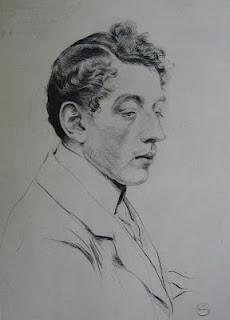 Robert Raudner (1854-1910)Kopf eines alten MannesEtching, 1892
Robert Raudner (1854-1910)Kopf eines alten MannesEtching, 1892A traditional approach for a traditional subject, in this strong depiction of a man who has known a life of hard work, and perhaps some disappointment.
 Josef Damberger (1867-1951)Am häuslichen HerdEtching, 1894
Josef Damberger (1867-1951)Am häuslichen HerdEtching, 1894This strongly-composed etching by Josef Damberger intrigues me. You get a real sense of family relationships and tensions in the group dynamics of the picture. The title means something like At the Domestic Hearth. The mother and daughter are there, with the child looking yearningly out of the picture, grandfather and grandmother are looking on, at an emotional remove from the others. Where is the father? This picture seems to pre-figure the stark social conscience of Expressionist artists such as Käthe Kollwitz
 Ferdinand Schmutzer (1870-1928)Holländisches MädchenEtching, 1896
Ferdinand Schmutzer (1870-1928)Holländisches MädchenEtching, 1896I find the intimacy of some of these scenes very touching - especially Ferdinand Schmutzer's tenderly-observed Dutch girl, Bernhard Pankok's twilit mother and child, and, further down the post, Alfred Cossman's housewife quietly sat over her mending.
 Bernhard Pankok (1872-1943)Frau mit KindMezzotint, 1898
Bernhard Pankok (1872-1943)Frau mit KindMezzotint, 1898 Otto Rasch (1862-1952)Unterbrochene AndachtLithograph, 1898
Otto Rasch (1862-1952)Unterbrochene AndachtLithograph, 1898This old lady has been interrupted at her devotions, and she doesn't look best pleased about it.
 Heinrich Wolff (1875-1940)MädchenkopfEtching, 1897
Heinrich Wolff (1875-1940)MädchenkopfEtching, 1897 Heinrich Wolff (1875-1940)PorträtEtching, 1898
Heinrich Wolff (1875-1940)PorträtEtching, 1898 Heinrich Wolff (1875-1940)StudienkopfMezzotint, 1899
Heinrich Wolff (1875-1940)StudienkopfMezzotint, 1899I wonder if Heinrich Wolff's Studienkopf is, like Hans Thoma's etching below, a self-portrait; certainly his Porträt must be a recognisable figure, though I don't know which senior German artist this is.
 Hans Thoma (1839-1924)SelbstbildnisEtching, 1898
Hans Thoma (1839-1924)SelbstbildnisEtching, 1898 Alfred Cossmann (1870-1951)PorträtstudieEtching, 1899
Alfred Cossmann (1870-1951)PorträtstudieEtching, 1899 Heinrich Reifferscheid (1872-1945)PorträtEtching, 1898
Heinrich Reifferscheid (1872-1945)PorträtEtching, 1898 Marie Stein (active in Paris 1899)PorträtstudieEtching, 1899
Marie Stein (active in Paris 1899)PorträtstudieEtching, 1899I haven't been able to find out anything about Marie Stein. Although she has a French first name, I think she was probably German. There's quite a bit of writing very faintly incised with a drypoint needle in the top left of the image, but I haven't been able to make any of it out, partly because it's all in reverse.
 Paul Hey (1867-1952)PorträtstudieEtching, 1899
Paul Hey (1867-1952)PorträtstudieEtching, 1899If the very first image in this post, Robert Raudner's old man, had a timeless quality, this fashionable woman by Paul Hey is the very image of 1890s femininity. I love the drama that the unusual upward-looking perspective gives this, as if the artist were lying on the ground looking up at her.
 Georg Jahn (1869-1941)Porträt einer alten FrauEtching, 1900
Georg Jahn (1869-1941)Porträt einer alten FrauEtching, 1900The detail in this etching by Georg Jahn is quite incredible. You really feel that this kindly old lady might start speaking to you.
 Hanns Fechner (1860-1931)PorträtLithograph, 1900
Hanns Fechner (1860-1931)PorträtLithograph, 1900The lithographs by Hanns Fechner (above) and Rudolph Schulte im Hofe (below) both approach their subjects at an angle, allowing us the sense that we are observing someone who doesn't know that we are looking, and is lost in her own thoughts.
 Rudolf Schulte im Hofe (1865-1928)PorträtLithograph, 1901
Rudolf Schulte im Hofe (1865-1928)PorträtLithograph, 1901 Hermann Struck (1876-1944)Porträt eines alten MannesEtching, 1901
Hermann Struck (1876-1944)Porträt eines alten MannesEtching, 1901And last of all, Hermann Struck's magnificent etching of an elderly Jew, possibly the artist's father. There's a real sense of emotional connection here, and of the weight of history. "Next year in Jerusalem," seems to sum up his thoughts. Hermann Struck (born Chaim Aaron ben David) was himself an early settler in what was then Palestine, immigrating to Haifa in 1923.

